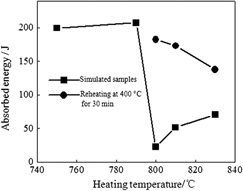Article contents
A new method to study the effect of M–A constituent on impact toughness of IC HAZ in Q690 steel
Published online by Cambridge University Press: 11 June 2015
Abstract

This paper details an investigation into the effect of martensite–austenite (M–A) constituent on impact toughness of intercritical heat-affected zone (IC HAZ) in Q690 steel, a low carbon bainitic steel. Large samples with uniform microstructure similar to that of the actual IC HAZ were achieved through combinations of heat treatments. The samples were heated to temperature between 750 and 830 °C for 30 min and then quenched in water. After these heat treatments, hard martensite islands distribute along the boundaries of soft matrix, and the size of martensite islands increases with heating temperature. The microstructure is quite similar to that of the IC HAZ. Using these large samples, the impact toughness could be measured conveniently. It was found that the embrittlement of the IC HAZ depends on the deformability and size of the M–A constituent. When the size of the M–A constituent whose deformability is low exceeds a critical value (2.0 μm), the embrittlement of the IC HAZ occurs.
- Type
- Articles
- Information
- Copyright
- Copyright © Materials Research Society 2015
References
REFERENCES
- 9
- Cited by




